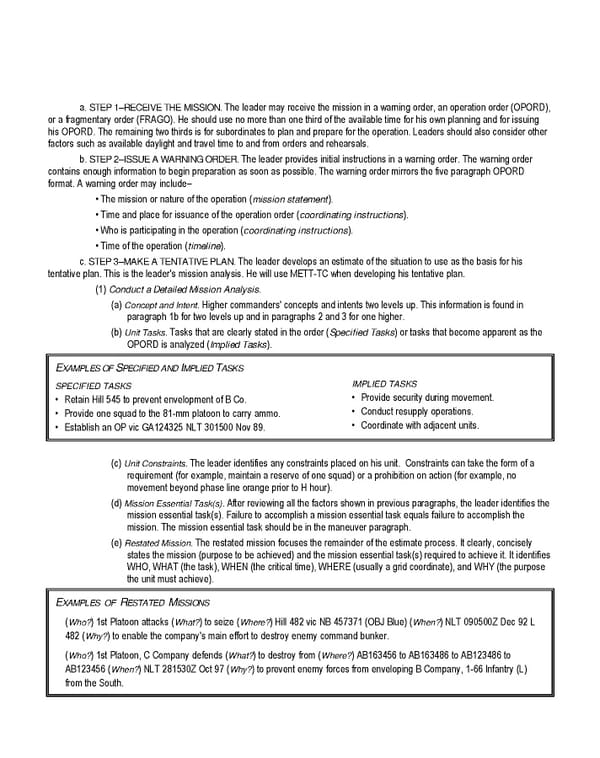a. STEP 1–RECEIVE THE MISSION. The leader may receive the mission in a warning order, an operation order (OPORD), or a fragmentary order (FRAGO). He should use no more than one third of the available time for his own planning and for issuing his OPORD. The remaining two thirds is for subordinates to plan and prepare for the operation. Leaders should also consider other factors such as available daylight and travel time to and from orders and rehearsals. b. STEP 2–ISSUE A WARNING ORDER. The leader provides initial instructions in a warning order. The warning order contains enough information to begin preparation as soon as possible. The warning order mirrors the five paragraph OPORD format. A warning order may include– • The mission or nature of the operation (mission statement). • Time and place for issuance of the operation order (coordinating instructions). • Who is participating in the operation (coordinating instructions). • Time of the operation (timeline). c. STEP 3–MAKE A TENTATIVE PLAN. The leader develops an estimate of the situation to use as the basis for his tentative plan. This is the leader's mission analysis. He will use METT-TC when developing his tentative plan. (1) Conduct a Detailed Mission Analysis. (a) Concept and Intent. Higher commanders' concepts and intents two levels up. This information is found in paragraph 1b for two levels up and in paragraphs 2 and 3 for one higher. (b) Unit Tasks. Tasks that are clearly stated in the order (Specified Tasks) or tasks that become apparent as the OPORD is analyzed (Implied Tasks). EXAMPLES OF SPECIFIED AND IMPLIED TASKS SPECIFIED TASKS • Retain Hill 545 to prevent envelopment of B Co. • Provide one squad to the 81-mm platoon to carry ammo. • Establish an OP vic GA124325 NLT 301500 Nov 89. IMPLIED TASKS • Provide security during movement. • Conduct resupply operations. • Coordinate with adjacent units. (c) Unit Constraints. The leader identifies any constraints placed on his unit. Constraints can take the form of a requirement (for example, maintain a reserve of one squad) or a prohibition on action (for example, no movement beyond phase line orange prior to H hour). (d) Mission Essential Task(s). After reviewing all the factors shown in previous paragraphs, the leader identifies the mission essential task(s). Failure to accomplish a mission essential task equals failure to accomplish the mission. The mission essential task should be in the maneuver paragraph. (e) Restated Mission. The restated mission focuses the remainder of the estimate process. It clearly, concisely states the mission (purpose to be achieved) and the mission essential task(s) required to achieve it. It identifies WHO, WHAT (the task), WHEN (the critical time), WHERE (usually a grid coordinate), and WHY (the purpose the unit must achieve). EXAMPLES OF RESTATED MISSIONS (Who?) 1st Platoon attacks (What?) to seize (Where?) Hill 482 vic NB 457371 (OBJ Blue) (When?) NLT 090500Z Dec 92 L 482 (Why?) to enable the company's main effort to destroy enemy command bunker. (Who?) 1st Platoon, C Company defends (What?) to destroy from (Where?) AB163456 to AB163486 to AB123486 to AB123456 (When?) NLT 281530Z Oct 97 (Why?) to prevent enemy forces from enveloping B Company, 1-66 Infantry (L) from the South.
 Ranger Handbook Page 23 Page 25
Ranger Handbook Page 23 Page 25